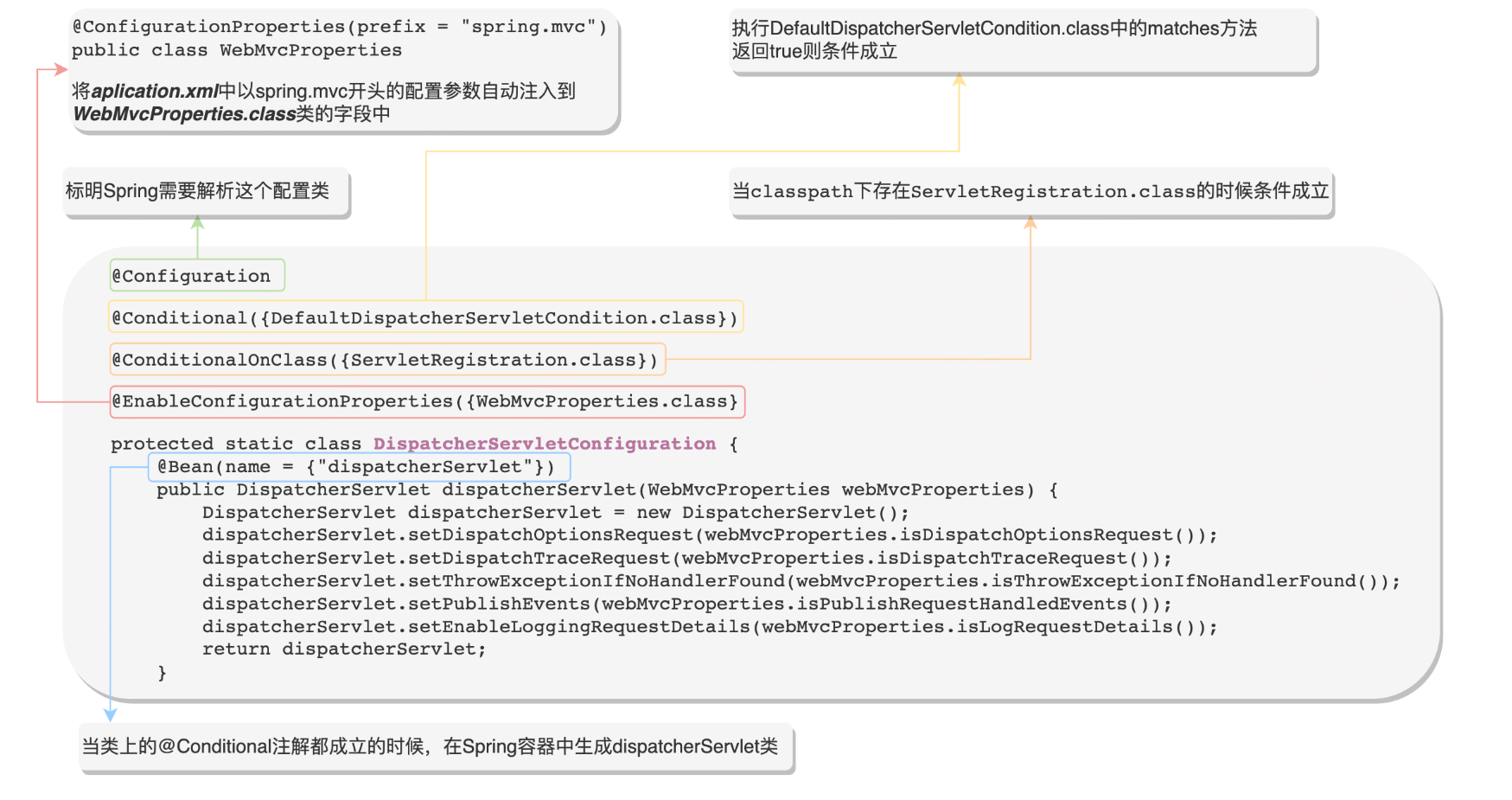SpringBoot自動設定原理解析
1: 什麼是SpringBoot自動設定
首先介紹一下什麼是SpringBoot,SpringBoost是基於Spring框架開發出來的功能更強大的Java程式開發框架,其最主要的特點是:能使程式開發者快速搭建一套開發環境。SpringBoot能將主流的開發框架(例如SpringMVC,Dubbo,Mybatis,Redis等),做到像Maven匯入Jar包一樣的簡潔快速,做到開箱即用。其中最關鍵的技術就是SpringBoot客製化的各種Starter,通Maven引入Starter就能快速搭建開發環境。
2: SpringBoot Starter自動裝配案例
在以前單獨使用SpringMVC Web程式設計框架時,我們需要單獨設定_DispatcherServlet和Tomcat,使用SpringBoot之後,我們只需要引入SpringBoot-Starter-Web就能直接開始編寫Controller等Web相關的程式碼,這就是SpringBoot為們提供的開箱即用的便捷能力,下面就以SpringBoot-Starter-Web_來說明SpringBoot自動設定的關鍵原理
3: SpringBoot自動裝配案例原始碼解析
3.1 DispatcherServlet的自動設定原理
首先我們定位到SpringBoot自動設定的Maven依賴
<dependency>
<groupId>org.springframework.boot</groupId>
<artifactId>spring-boot-autoconfigure</artifactId>
<version>${spring-boot.version}</version>
</dependency>
在依賴的Jar包中我們可以在_META-INF/spring.factories_中找到自動設定類:
org.springframework.boot.autoconfigure.web.servlet.DispatcherServletAutoConfiguration
在這個類中存在有一個靜態內部類:
org.springframework.boot.autoconfigure.web.servlet.DispatcherServletAutoConfiguration.DispatcherServletConfiguration
下圖是這個設定類的主要原始碼和解析:

下面將上圖中關鍵的註解功能,分別進行功能說明
3.1.1:@EnableConfigurationProperties({WebMvcProperties.class})註解解析
這個註解表示使_WebMvcProperties.class類上的@ConfigurationProperties這個註解生效,同時@ConfigurationProperties這個註解是將application.xml中以spring.mvc開頭的設定引數自動注入到WebMvcProperties.class_類的欄位中
3.1.2:@Conditional({DefaultDispatcherServletCondition.class}註解解析
該註解的原理就是將滿足特定條件情況下的Bean自動載入到Spring容器中,該註解對應的Spring介面就是_org.springframework.context.annotation.Condition_這個介面
public interface Condition {
boolean matches(ConditionContext var1, AnnotatedTypeMetadata var2);
}
3.1.3:@ConditionOnClass註解解析
_@ConditionOnClass這個註解是在當程式程式碼環境classpath下存在xxx.class的情況下條件成立,同時最終也會呼叫到matches_方法中,其中關鍵的原始碼如下:
protected static Class<?> resolve(String className, ClassLoader classLoader) throws ClassNotFoundException {
return classLoader != null ? Class.forName(className, false, classLoader) : Class.forName(className);
}
從上面可以看到,程式碼利用_Class.forName方法載入classpath下的xxx.class類,如果載入成功條件就會成立。最後,在滿足了所有@ConditionOnal註解條件後,SpringBoot就會自動為我們在Spring容器中注入DispatcherServlet了,無需單獨設定了,直接引入spring-boot-starter-web_r即可開始使用web相關功能。
3.1.4:總結
我們以DispatcherServlet是如何自動設定到容器中為例,探究了SpringBoot Starter的自動設定原理,其中涉及了幾個關鍵的註解和步驟:
第一步:涉及到了組態檔的讀取和個性化設定,這裡就涉及到了下面這兩個註解
@ConfigurationProperties
@EnableConfigurationProperties
第二步:設計到了在什麼條件下才自動設定的註解
@Conditional
@ConditionalOnClass
第三步:約定了自動設定類的載入路徑
/META-INF/spring-factories
org.springframework.boot.autoconfigure.EnableAutoConfiguration=自動設定類全路徑名稱
在我們瞭解到了SpringBoot自動設定的原理之後,我們就可以自定義一個SpringBoot Starter來快速搭建我們的開發環境了
4:自定義一個列印輸入輸出紀錄檔的Starter
4.1 首先定義一個標記需要列印出入參紀錄檔的註解@PrintLog
@Target(ElementType.METHOD)
@Retention(RetentionPolicy.RUNTIME)
public @interface PrintLog {
}
4.2 定義一個存放列印紀錄檔設定的實體類
//自動注入application組態檔中已log.switch開頭的設定引數
@ConfigurationProperties("log.switch")
public class LogProperties {
//是否啟用列印紀錄檔功能
private Boolean enabled = false;
//是否列印呼叫者ip
private Boolean printIp = false;
//是否列印呼叫者url
private Boolean printUrl = false
}
4.3 定義一個@PrintLog註解的切面類
@Aspect
public class LogAspect {
private static final Log LOGGER = LogFactory.getLog(LogAspect.class);
private LogProperties logProperties;
@Pointcut("@annotation(com.zl.annotation.PrintLog)")
public void Log(){}
@Around("Log()")
public Object doAround(ProceedingJoinPoint joinPoint) throws Throwable {
ServletRequestAttributes attributes = (ServletRequestAttributes) RequestContextHolder.getRequestAttributes();
HttpServletRequest request = attributes.getRequest();
MethodSignature signature = (MethodSignature) joinPoint.getSignature();
Method method = signature.getMethod();
String methodName = method.getName();
//列印呼叫url
if (Boolean.TRUE.equals(logProperties.getPrintUrl())){
LOGGER.info("URL:" + request.getRequestURL().toString());
}
//列印ip
if (Boolean.TRUE.equals(logProperties.getPrintIp())) {
LOGGER.info("IP :" + request.getRemoteAddr());
}
//列印方法
LOGGER.info("method :" + methodName);
//列印引數
LOGGER.info("parameter :" + Arrays.toString(joinPoint.getArgs()));
Object result = joinPoint.proceed();
//列印返回結果
LOGGER.info("return :" + JSON.toJSONString(result));
return result;
}
}
4.4 定義一個列印紀錄檔的自動設定類
@Configuration
@EnableConfigurationProperties({LogProperties.class})
//表示在application組態檔中必須設定log.switch.enabled = true才啟動自動設定
@ConditionalOnProperty(prefix = "log.switch", value = "enabled", havingValue = "true")
public class LogAutoConfigure {
@Bean
//Advice.class是aop切面中關鍵的切面方法類(@Before,@After等)
//程式中有Advice.class類說明需要使用切面功能,這時才載入自定義的切面類
@ConditionalOnClass(Advice.class)
public LogAspect webLogAspect(LogProperties logProperties){
return new LogAspect(logProperties);
}
}
@ConditionalOnProperty表示在application組態檔中必須存在相應的設定才能使條件成立
4.5 設定自定義設定類的載入路徑
META-INF/spring.factories
org.springframework.boot.autoconfigure.EnableAutoConfiguration=\
com.zl.autoConfigure.LogAutoConfigure
4.6 Maven打包部署
maven install
5:開始使用自定義的Starter
5.1 在專案中引入Starter
<dependency>
<groupId>com.zl.demo</groupId>
<artifactId>LogStarter</artifactId>
<version>1.0-SNAPSHOT</version>
</dependency>
5.2 在application.yml中設定引數
log:
switch:
enabled: true //啟用列印紀錄檔功能
printIp: true //列印請求ip
printUrl: true //列印請求url
經過上面兩個步驟就,列印紀錄檔的功能就已經開啟了,接下來就可以進行編碼測試了
5.3 定義一個Controller並標上列印紀錄檔的註解
@RestController
@RequestMapping("/test")
public class HelloWorldController {
@PrintLog
@RequestMapping("/hello")
public String helleWorld(String test){
return "hello world!";
}
}
5.4 啟動專案開始測試
com.zl.aspect.LogAspect : URL:http://localhost:8080/test/hello
com.zl.aspect.LogAspect : IP :0:0:0:0:0:0:0:1
com.zl.aspect.LogAspect : method :helleWorld
com.zl.aspect.LogAspect : parameter :[test]
com.zl.aspect.LogAspect : return :"hello world!"
可以看到上面的入參和返回值都已經列印出來了,說明了自定義的starter已經生效了。
6:總結
SpringBoot自動設定功能帶給我們的是開箱即用,快速便捷的功能,自動設定為我們研發人員帶來的優點,我主要總結為以下兩點:
1:提高研發效率。我們可以快速構建開發環境,對於開發中使用到的開源元件和中介軟體,我們直接引入對應的Starter就可以直接開發了,例如Redis和Mybatis等,可以直接引入對應的_spring-boot-starter-data-redis就可以直接使用RedisTemplate來操作Redis了,這樣可以極大的提高研發的效率,無需再進行復雜的起步設定了和各種版本依賴管理了。
2:標準模組複用。對於業務開發中的一些_標準模組,例如常用的一些三方服務,我們可以利用Starter直接設定好,在需要使用的專案中直接引入這個starter就可以立即使用了,無需再去引入Jar包和編寫組態檔等,同樣的,對於一些標準非業務強耦合的功能_,例如監控,鑑權等,也可以定義一個Starter,需要使用鑑權和監控功能的專案就可以直接複用了,無需再次開發。
作者:京東零售 鍾磊
來源:京東雲開發者社群 自猿其說Tech 轉載請註明來源